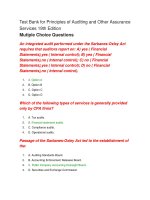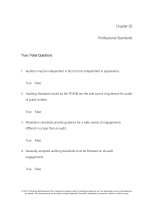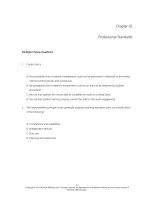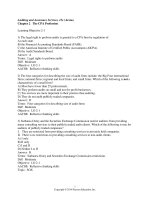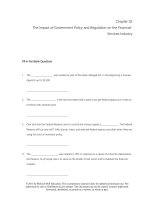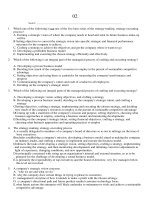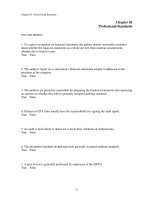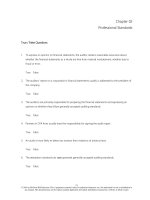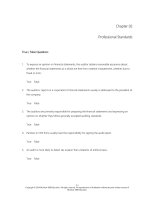Principles of auditing and other assurance services 18th edition whittington test bank
Bạn đang xem bản rút gọn của tài liệu. Xem và tải ngay bản đầy đủ của tài liệu tại đây (147.82 KB, 38 trang )
Chapter 02 - Professional Standards
Chapter 02
Professional Standards
True / False Questions
1. To express an opinion on financial statements, the auditor obtains reasonable assurance
about whether the financial statements as a whole are free from material misstatement,
whether due to fraud or error.
True False
2. The auditors' report on a corporation's financial statements usually is addressed to the
president of the company.
True False
3. The auditors are primarily responsible for preparing the financial statements and expressing
an opinion on whether they follow generally accepted auditing standards.
True False
4. Partners in CPA firms usually have the responsibility for signing the audit report.
True False
5. An audit is more likely to detect tax evasion than violations of antitrust laws.
True False
6. The attestation standards do not supersede generally accepted auditing standards.
True False
7. A peer review is generally performed by employees of the AICPA.
True False
2-1
Chapter 02 - Professional Standards
8. If the auditors discover illegal acts by a client, they ordinarily must immediately resign
from the engagement.
True False
9. An audit should be designed to obtain reasonable assurance of detecting non-compliance
with all laws.
True False
10. The pronouncements of the International Auditing and Assurance Standards Board do not
override the national auditing standards of its members, even when financial statements are
issued by a multinational company.
True False
Multiple Choice Questions
11. Audits of financial statements are designed to obtain reasonable assurance of detecting
misstatement due to:
A. Option A
B. Option B
C. Option C
D. Option D
12. Financial statements are prepared following a(an)
A. Applicable financial reporting framework.
B. Appropriate subject matter.
C. Generally accepted auditing standards.
D. Set of quality control standards.
2-2
Chapter 02 - Professional Standards
13. An attestation engagement:
A. Has as its primary source of standards the assurance standards.
B. Includes a report on subject matter, or on an assertion about subject matter.
C. Includes search and verification procedures for all major accounts.
D. Is ordinarily an examination, review or compilation engagement.
14. An audit provides reasonable assurance of detecting which of the following types of
material illegal acts?
A. Option A
B. Option B
C. Option C
D. Option D
15. Which of the following is not a type of auditors' opinion?
A. Adverse.
B. Ordinary.
C. Qualified.
D. Unmodified.
16. Which of the following is one of the elements of AICPA quality control?
A. Assurance of proper levels of association.
B. Due professional care.
C. Engagement performance.
D. Supervision.
2-3
Chapter 02 - Professional Standards
17. A procedure in which a quality control partner periodically tests the application of quality
control procedures is most directly related to which quality control element?
A. Engagement performance.
B. Human resources.
C. Leadership responsibilities for quality with the firm.
D. Monitoring.
18. Requirements for training, independence and due professional care are included in which
group of the generally accepted auditing standards of the PCAOB?
A. Fieldwork.
B. General.
C. Reporting.
D. Quality control.
19. Which of the following is a principle underlying an audit conducted in accordance with
generally accepted auditing standards?
A. The audit provides reasonable assurance the client will remain in business for at least one
year.
B. The audit report expresses an opinion on whether the financial statements are free of
material and immaterial misstatement.
C. Auditors are responsible for, among other things, maintaining professional objectivism,
exercising professional engagement, and obtaining appropriate documentation.
D. An auditor's opinion enhances the degree of confidence that intended users can place in the
financial statements.
20. A set of criteria used to determine measurement, recognition, representation, and
disclosure of all material items appearing in the financial statements is referred to as a(n)
A. Financial reporting framework.
B. Public Company Accounting Oversight Board Criteria.
C. Quality control presentation standard.
D. Special purpose audit standard.
2-4
Chapter 02 - Professional Standards
21. An audit should be designed to obtain reasonable assurance of detecting material
misstatements due to:
A. Errors.
B. Errors and fraud.
C. Errors, fraud, and noncompliance with laws with a direct effect on financial statement
amounts.
D. Errors, fraud and noncompliance with all laws.
22. Which of the following is accurate, as indicated in the principles underlying an audit?
A. Management is expected to provide the auditors with all needed evidence prior to the
beginning of audit work.
B. An auditor is unable to obtain absolute assurance that the financial statements are free from
material misstatement.
C. Auditors are responsible for having appropriate competence to perform the audit without
the assistance of outside specialists.
D. Management is responsible for preparing accurate financial statement amounts, while
auditors are responsible for auditing those amounts and for preparing note disclosures related
to those amounts.
23. Which of the following is not an underlying premise of an audit?
A. Management must provide the auditor with all information relevant to the preparation and
fair presentation of the financial statements.
B. Management and the auditors have responsibility for the preparation of financial
statements in accordance with the applicable financial reporting framework.
C. Where appropriate, the auditor may obtain information from those charged with
governance.
D. The auditors should be provided unrestricted access to those within the entity from whom
the auditor determines it necessary to obtain audit evidence.
2-5
Chapter 02 - Professional Standards
24. By definition, proper professional skepticism on an audit requires
A. Option A
B. Option B
C. Option C
D. Option D
25. When a Statement Auditing Standards uses the word "should" relating to a requirement, it
means that the auditor:
A. Must fulfill the responsibilities under all circumstances.
B. Must comply with requirements unless the auditor demonstrates and documents that
alternative actions are sufficient to achieve the objectives of the standards.
C. Should consider whether to follow the advice based on the exercise of professional
judgment in the circumstances.
D. May choose to change responsibilities relating to various professional standards that
remain under consideration.
26. An unconditional responsibility to follow an AICPA professional standard exists when the
professional standard uses the term(s)
A. Option A
B. Option B
C. Option C
D. Option D
2-6
Chapter 02 - Professional Standards
27. Which of the following best describes a portion of the auditors' responsibility regarding
noncompliance with laws by clients?
A. The auditors have a responsibility to discover all material noncompliance.
B. If audit procedures reveal noncompliance, the auditors should take appropriate actions.
C. If the auditors suspect noncompliance, they should conduct a legal audit of the company.
D. The auditors' responsibility for the detection of all noncompliance is the same as their
responsibility regarding material misstatements due to errors and fraud.
28. The auditors who find that the client has committed an illegal act would be most likely to
withdraw from the engagement when the:
A. Management fails to take appropriate corrective action.
B. Illegal act has material financial statement implications.
C. Illegal act has received widespread publicity.
D. Auditors cannot reasonably estimate the effect of the illegal act on the financial statements.
29. Which of the following is not included as a part of the description of the auditor's
responsibility in a nonpublic company unmodified report?
A. The audit was performed in accordance with generally accepted accounting principles.
B. An audit involves performing procedures to obtain audit evidence about the amounts and
disclosures in the financial statements.
C. The procedures selected depend on the auditor's judgment.
D. An audit includes evaluating the appropriateness of accounting policies used.
30. Primary responsibility for the financial statements lies with:
A. Option A
B. Option B
C. Option C
D. Option D
2-7
Chapter 02 - Professional Standards
31. Which of the following is explicitly included as a part of the description of management's
responsibility in an unmodified audit report?
A. Management is responsible for making a judgment on which misstatements are material vs.
immaterial.
B. Management is responsible for providing auditors with all relevant evidence.
C. Management is responsible for the design, implementation, and maintenance of internal
control.
D. Management is responsible for listing all illegal acts with a direct effect on financial
statement amounts and disclosures.
32. The auditors' report for a nonpublic company should indicate:
A. That the audit was made in accordance with auditing standards generally accepted in the
United States of America.
B. Any weakness in internal control observed by the auditors.
C. That accounting principles have been consistently applied.
D. That no illegal acts have been identified.
33. The Auditing Standards Board's guidance on matters such as the purpose of an audit, the
premise of an audit, and auditor personal responsibilities is included in:
A. The 10 Generally Accepted Auditing Standards.
B. The Code of Professional Conduct.
C. Accounting Series Releases.
D. Principles Underlying an Audit Conducted in Accordance with GAAS.
34. A requirement that working papers be reviewed by the supervisor, and any deficiencies be
discussed with the preparer is an example of a quality control procedure in the area of:
A. Acceptance and continuance of client relationships and specific engagements.
B. Engagement performance.
C. Human resources.
D. Relevant ethical requirements.
2-8
Chapter 02 - Professional Standards
35. A requirement to design recruitment processes and procedures to help the firm select
individuals meeting minimum academic requirements established by the firm is an example of
a quality control procedure in the area of:
A. Acceptance and continuance of client relationships and specific engagements.
B. Engagement performance.
C. Human resources.
D. Relevant ethical requirements.
36. The body that issues international pronouncements providing auditing procedural and
reporting guidance is the:
A. International Federation of Auditors.
B. Multinational Reporting Commission.
C. International Auditing and Assurance Standards Board.
D. AICPA Auditing Standards Board.
37. To present fairly in conformity with generally accepted accounting principles the financial
statements must:
A. Be consistently applied.
B. Inform users of all matters that could materially affect a decision.
C. Reflect transactions and events within a range of reasonable limits.
D. Be considered preferable to the users of those financial statements.
38. Which of the following is not included in the auditors' standard unmodified audit report?
A. The procedures selected by the auditor depend on the auditor's judgment.
B. An audit includes evaluating the appropriateness of accounting policies used.
C. An audit includes evaluating the overall presentation of the financial statements.
D. Accounting principles have been consistently applied.
2-9
Chapter 02 - Professional Standards
39. An audit performed in accordance with generally accepted auditing standards generally
should:
A. Be expected to provide absolute assurance that noncompliance with all laws will be
detected where internal control is effective.
B. Be relied upon to disclose violations of truth in lending laws.
C. Encompass a plan to actively search for all illegalities which relate to operating aspects.
D. Not be relied upon to provide absolute assurance that all noncompliance with laws will be
detected.
40. When the auditors express an opinion on financial statements their responsibilities extend
to:
A. The underlying wisdom of their client's management decisions.
B. Whether the results of their client's operating decisions are fairly presented in the financial
statements.
C. Active participation in the implementation of the advice given to their client.
D. An ongoing responsibility for their client's solvency.
41. Authoritative GAAP sources include:
A. Option A
B. Option B
C. Option C
D. Option D
2-10
Chapter 02 - Professional Standards
42. An investor reading the financial statements of The Sundby Corporation observes that the
statements are accompanied by an unmodified auditors' report. From this the investor may
conclude that:
A. Any disputes over significant accounting issues have been settled to the auditors'
satisfaction.
B. The auditors are satisfied that Sundby is operationally efficient.
C. The auditors have ascertained that Sundby's financial statements have been prepared
accurately.
D. Informative disclosures in the financial statements but not necessarily in the footnotes are
to be regarded as reasonably adequate.
43. The auditors' report may be addressed to the company whose financial statements are
being examined or to that company's:
A. Chief operating officer.
B. President.
C. Board of Directors.
D. Chief financial officer.
44. Which of the following best describes what is meant by generally accepted auditing
standards?
A. Acts to be performed by the auditors.
B. Measures of the quality of the auditors' performance.
C. Procedures to be used to gather evidence to support financial statements.
D. Audit objectives generally determined on audit engagements.
45. If noncompliance with a law is discovered during the audit of a publicly held company,
the auditors should first:
A. Notify the regulatory authorities.
B. Determine who was responsible for the noncompliance.
C. Intensify the examination to identify noncompliance with any laws.
D. Report the act to high level personnel within the client's organization and to the audit
committee.
2-11
Chapter 02 - Professional Standards
46. Which of the following is the name used to describe financial reporting frameworks other
than GAAP which include: cash basis, tax basis, regulatory basis, or contractual basis?
A. Applicable.
B. PCAOB.
C. Special reports.
D. Special purpose.
47. Which of the following statements best describes the primary purpose of Statements on
Auditing Standards?
A. They are guides intended to set forth auditing procedures which are applicable to a variety
of situations.
B. They are procedural outlines which are intended to narrow the areas of inconsistency and
divergence of auditor opinion.
C. They are authoritative statements, enforced through the Code of Professional Conduct.
D. They are interpretations which may be useful guidance to auditors.
48. The primary responsibility for the adequacy of disclosure in the financial statements of a
publicly held company rests with the:
A. Partner assigned to the audit engagement.
B. Management of the company.
C. Auditor in charge of the fieldwork.
D. Securities and Exchange Commission.
49. Within the context of quality control, the primary purpose of continuing professional
education and training activities is to enable a CPA firm to provide personnel within the firm
with:
A. Technical training that assures proficiency as an auditor.
B. Professional education that is required in order to perform with due professional care.
C. Knowledge required to fulfill assigned responsibilities and to progress within the firm.
D. Knowledge required in order to perform a peer review.
2-12
Chapter 02 - Professional Standards
50. In pursuing a CPA firm's quality control objectives, a CPA firm may maintain records
indicating which partners or employees of the CPA firm were previously employed by the
CPA firm's clients. Which quality control objective would this be most likely to satisfy?
A. Acceptance and continuance of clients and engagements.
B. Engagement performance.
C. Personnel management.
D. Relevant ethical requirements.
51. A CPA firm establishes quality control policies and procedures for deciding whether to
accept a new client or continue to perform services for a current client. The primary purpose
for establishing such policies and procedures is:
A. To enable the auditor to attest to the integrity or reliability of a client.
B. To comply with the quality control standards established by regulatory bodies.
C. To minimize the likelihood of association with clients whose managements lack integrity.
D. To lessen the exposure to litigation resulting from failure to detect fraud in client financial
statements.
52. Which of the following is not an element of quality control?
A. Documentation.
B. Engagement performance.
C. Monitoring.
D. Relevant ethical requirements.
53. Generally accepted auditing standards established by the AICPA through April of 2003:
A. Have been accepted as interim standards by the Public Company Accounting Oversight
Board.
B. Provide accounting guidance for nonpublic companies.
C. Have all been superseded by Public Company Accounting Oversight Board standards.
D. Are now developed by the Securities and Exchange Commission.
2-13
Chapter 02 - Professional Standards
54. The Public Company Accounting Oversight Board has authority to establish which of the
following relating to public companies?
A. Option A
B. Option B
C. Option C
D. Option D
55. Which of the following is least likely to be directly examined in an inspection performed
by the PCAOB?
A. Audit engagements.
B. Review engagements.
C. Compilation engagements.
D. CPA firm quality control system.
56. As compared with the US public company audit report, the international audit report:
A. Is shorter in length.
B. Includes enhanced explanation of the audit process.
C. Includes the name of the partner and managers on the audit, while the US report includes
only the CPA firm name.
D. Is dated as of year-end, whereas the US report is dated as of the last date of significant
field work.
57. A peer review in which the peer reviewers study and appraise a CPA firm's system of
quality control to perform accounting and auditing work is referred to as a(n):
A. Engagement review.
B. Inspection review.
C. Supervision review.
D. System review.
2-14
Chapter 02 - Professional Standards
58. An engagement review form of peer review is least likely to include a peer reviewer's
detailed analysis of:
A. Compilation reports.
B. Documentation of procedures followed on a review.
C. Overall system of quality control.
D. Review reports.
59. Of the following, which are current types of peer review?
A. Option A
B. Option B
C. Option C
D. Option D
2-15
Chapter 02 - Professional Standards
Matching Questions
60. Indicate whether you agree or disagree with the following statements concerning a
financial statement audit conducted in accordance with generally accepted auditing standards.
1. When an auditing standard uses the word
"should," this indicates that the auditor must in all
cases follow it if the requirement is relevant to the
company being audited
2. Audits provide absolute assurance of detecting
material misstatements and reasonable assurance of
detecting immaterial misstatements
3. At one point, the Public Company Oversight
Board adopted the AICPA auditing standards in
existence as its interim auditing standards
4. International auditing standards are developed by
the International Auditing and Assurance Standards
Board
5. For audit purposes, professional skepticism
includes a questioning mind and a critical assessment
of audit evidence and should be maintained
throughout the planning and performance of an audit
6. The Auditing Standards Board issues accounting
principles for nonpublic company audits while the
Public Company Accounting Oversight Board issues
accounting principles for public company audits
7. Auditors have a higher responsibility for detecting
noncompliance with laws affecting financial
statement amounts and disclosures than they do for
other laws
8. Public companies are ordinarily audited by a CPA
firm, with engagement review by the General
Accounting Office
2-16
Disagree ____
Disagree ____
Agree ____
Disagree (auditing
standards, not
accounting
principles) ____
Agree ____
Disagree ____
Agree ____
Agree ____
Chapter 02 - Professional Standards
Essay Questions
61. The standard unmodified auditors' report for audits of nonpublic companies consists of
three paragraphs. Identify the three paragraphs and describe the purpose of each.
62. Auditors must consider the possibility of fraud by employees or management on every
audit engagement. They must also consider the possibility that the client has not complied
with laws.
(a) Distinguish between employee and management fraud.
(b) Describe the auditors' responsibility for the detection of fraud in an audit.
(c) Describe the auditors' responsibility regarding noncompliance with laws by a client.
2-17
Chapter 02 - Professional Standards
Chapter 02 Professional Standards Answer Key
True / False Questions
1. To express an opinion on financial statements, the auditor obtains reasonable assurance
about whether the financial statements as a whole are free from material misstatement,
whether due to fraud or error.
TRUE
Difficulty: Easy
2. The auditors' report on a corporation's financial statements usually is addressed to the
president of the company.
FALSE
Difficulty: Easy
3. The auditors are primarily responsible for preparing the financial statements and expressing
an opinion on whether they follow generally accepted auditing standards.
FALSE
Difficulty: Medium
4. Partners in CPA firms usually have the responsibility for signing the audit report.
TRUE
Difficulty: Medium
2-18
Chapter 02 - Professional Standards
5. An audit is more likely to detect tax evasion than violations of antitrust laws.
TRUE
Difficulty: Hard
6. The attestation standards do not supersede generally accepted auditing standards.
TRUE
Difficulty: Medium
7. A peer review is generally performed by employees of the AICPA.
FALSE
Difficulty: Medium
8. If the auditors discover illegal acts by a client, they ordinarily must immediately resign
from the engagement.
FALSE
Difficulty: Medium
9. An audit should be designed to obtain reasonable assurance of detecting non-compliance
with all laws.
FALSE
Difficulty: Medium
2-19
Chapter 02 - Professional Standards
10. The pronouncements of the International Auditing and Assurance Standards Board do not
override the national auditing standards of its members, even when financial statements are
issued by a multinational company.
TRUE
Difficulty: Medium
Multiple Choice Questions
11. Audits of financial statements are designed to obtain reasonable assurance of detecting
misstatement due to:
A. Option A
B. Option B
C. Option C
D. Option D
Difficulty: Hard
2-20
Chapter 02 - Professional Standards
12. Financial statements are prepared following a(an)
A. Applicable financial reporting framework.
B. Appropriate subject matter.
C. Generally accepted auditing standards.
D. Set of quality control standards.
Difficulty: Medium
13. An attestation engagement:
A. Has as its primary source of standards the assurance standards.
B. Includes a report on subject matter, or on an assertion about subject matter.
C. Includes search and verification procedures for all major accounts.
D. Is ordinarily an examination, review or compilation engagement.
Difficulty: Hard
14. An audit provides reasonable assurance of detecting which of the following types of
material illegal acts?
A. Option A
B. Option B
C. Option C
D. Option D
Difficulty: Medium
2-21
Chapter 02 - Professional Standards
15. Which of the following is not a type of auditors' opinion?
A. Adverse.
B. Ordinary.
C. Qualified.
D. Unmodified.
Difficulty: Medium
16. Which of the following is one of the elements of AICPA quality control?
A. Assurance of proper levels of association.
B. Due professional care.
C. Engagement performance.
D. Supervision.
Difficulty: Hard
17. A procedure in which a quality control partner periodically tests the application of quality
control procedures is most directly related to which quality control element?
A. Engagement performance.
B. Human resources.
C. Leadership responsibilities for quality with the firm.
D. Monitoring.
Difficulty: Hard
18. Requirements for training, independence and due professional care are included in which
group of the generally accepted auditing standards of the PCAOB?
A. Fieldwork.
B. General.
C. Reporting.
D. Quality control.
Difficulty: Medium
2-22
Chapter 02 - Professional Standards
19. Which of the following is a principle underlying an audit conducted in accordance with
generally accepted auditing standards?
A. The audit provides reasonable assurance the client will remain in business for at least one
year.
B. The audit report expresses an opinion on whether the financial statements are free of
material and immaterial misstatement.
C. Auditors are responsible for, among other things, maintaining professional objectivism,
exercising professional engagement, and obtaining appropriate documentation.
D. An auditor's opinion enhances the degree of confidence that intended users can place in the
financial statements.
Difficulty: Hard
20. A set of criteria used to determine measurement, recognition, representation, and
disclosure of all material items appearing in the financial statements is referred to as a(n)
A. Financial reporting framework.
B. Public Company Accounting Oversight Board Criteria.
C. Quality control presentation standard.
D. Special purpose audit standard.
Difficulty: Easy
21. An audit should be designed to obtain reasonable assurance of detecting material
misstatements due to:
A. Errors.
B. Errors and fraud.
C. Errors, fraud, and noncompliance with laws with a direct effect on financial statement
amounts.
D. Errors, fraud and noncompliance with all laws.
Difficulty: Hard
2-23
Chapter 02 - Professional Standards
22. Which of the following is accurate, as indicated in the principles underlying an audit?
A. Management is expected to provide the auditors with all needed evidence prior to the
beginning of audit work.
B. An auditor is unable to obtain absolute assurance that the financial statements are free from
material misstatement.
C. Auditors are responsible for having appropriate competence to perform the audit without
the assistance of outside specialists.
D. Management is responsible for preparing accurate financial statement amounts, while
auditors are responsible for auditing those amounts and for preparing note disclosures related
to those amounts.
Difficulty: Medium
23. Which of the following is not an underlying premise of an audit?
A. Management must provide the auditor with all information relevant to the preparation and
fair presentation of the financial statements.
B. Management and the auditors have responsibility for the preparation of financial
statements in accordance with the applicable financial reporting framework.
C. Where appropriate, the auditor may obtain information from those charged with
governance.
D. The auditors should be provided unrestricted access to those within the entity from whom
the auditor determines it necessary to obtain audit evidence.
Difficulty: Hard
2-24
Chapter 02 - Professional Standards
24. By definition, proper professional skepticism on an audit requires
A. Option A
B. Option B
C. Option C
D. Option D
Difficulty: Hard
25. When a Statement Auditing Standards uses the word "should" relating to a requirement, it
means that the auditor:
A. Must fulfill the responsibilities under all circumstances.
B. Must comply with requirements unless the auditor demonstrates and documents that
alternative actions are sufficient to achieve the objectives of the standards.
C. Should consider whether to follow the advice based on the exercise of professional
judgment in the circumstances.
D. May choose to change responsibilities relating to various professional standards that
remain under consideration.
Difficulty: Hard
2-25

